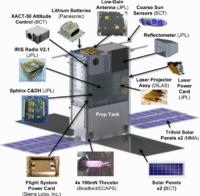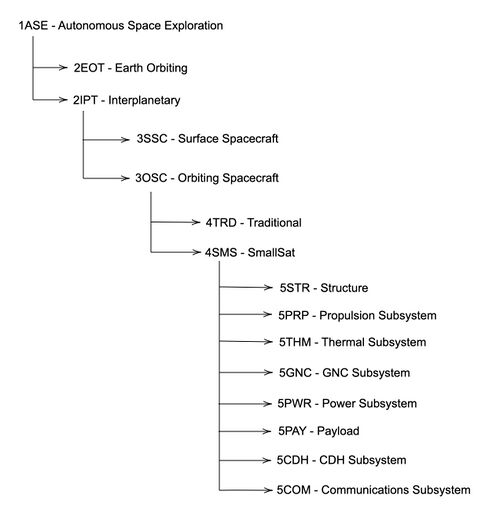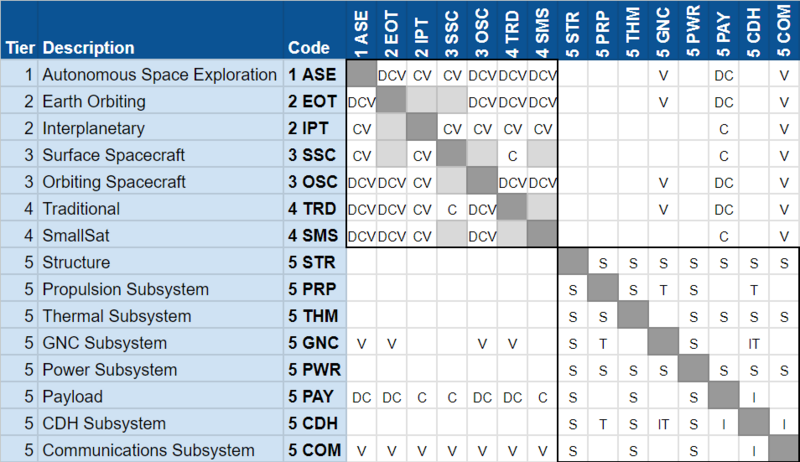Difference between revisions of "Interplanetary SmallSats"
| Line 48: | Line 48: | ||
==Technical Model== | ==Technical Model== | ||
===Morphological Matrix=== | ===Morphological Matrix=== | ||
{| class="wikitable" | |||
|- style="font-weight:bold; text-align:right; vertical-align:bottom;" | |||
! style="text-align:left;" | Subsystem | |||
! style="text-align:left;" | Component | |||
! style="text-align:left;" | Decision Variable | |||
! 1 | |||
! 2 | |||
! 3 | |||
! 4 | |||
|- style="text-align:right;" | |||
| rowspan="3" style="text-align:left;" | Communications | |||
| rowspan="3" style="text-align:left;" | DSN-Compatible Radio | |||
| style="vertical-align:bottom; text-align:left;" | Data rate [kbps] | |||
| style="vertical-align:bottom;" | 5313 | |||
| style="vertical-align:bottom;" | 20000 | |||
| style="vertical-align:bottom;" | 10000 | |||
| style="vertical-align:bottom;" | 6000 | |||
|- style="text-align:right;" | |||
| style="vertical-align:bottom; text-align:left;" | Transmitted Power [W] | |||
| style="vertical-align:bottom;" | 3 | |||
| style="vertical-align:bottom;" | 2.5 | |||
| style="vertical-align:bottom;" | 3 | |||
| style="vertical-align:bottom;" | 2 | |||
|- style="text-align:right;" | |||
| style="vertical-align:bottom; text-align:left;" | Mass [g] | |||
| style="vertical-align:bottom;" | 875 | |||
| style="vertical-align:bottom;" | 290 | |||
| style="vertical-align:bottom;" | 404 | |||
| style="vertical-align:bottom;" | 300 | |||
|- | |||
| rowspan="2" | Structure | |||
| rowspan="2" | Bus | |||
| style="vertical-align:bottom;" | Size | |||
| style="vertical-align:bottom;" | 3U | |||
| style="vertical-align:bottom;" | 6U | |||
| style="vertical-align:bottom;" | 12U | |||
| style="vertical-align:bottom;" | SmallSat | |||
|- | |||
| style="vertical-align:bottom;" | Maxmimum Mass | |||
| style="vertical-align:bottom;" | 6 kg | |||
| style="vertical-align:bottom;" | 14 kg | |||
| style="vertical-align:bottom;" | 25 kg | |||
| style="vertical-align:bottom;" | 250 kg | |||
|- | |||
| rowspan="2" | Power | |||
| rowspan="2" | Solar Panels | |||
| style="vertical-align:bottom;" | Cell Material | |||
| style="vertical-align:bottom;" | GaAs | |||
| style="vertical-align:bottom;" | ZTJ | |||
| style="vertical-align:bottom;" | CTJ30 | |||
| style="vertical-align:bottom;" | -- | |||
|- | |||
| style="vertical-align:bottom;" | Cell Efficiency | |||
| style="text-align:right; vertical-align:bottom;" | 30% | |||
| style="text-align:right; vertical-align:bottom;" | 29.50% | |||
| style="text-align:right; vertical-align:bottom;" | 29.50% | |||
| style="vertical-align:bottom;" | -- | |||
|- style="vertical-align:bottom;" | |||
| Propulsion | |||
| Propulsion System | |||
| Type | |||
| Cold gas | |||
| Ion | |||
| Propellant | |||
| Solar sail | |||
|- | |||
| rowspan="3" | GNC | |||
| style="vertical-align:bottom;" | Gyroscope | |||
| style="vertical-align:bottom;" | Type | |||
| style="vertical-align:bottom;" | Gyroscope | |||
| style="vertical-align:bottom;" | IMU | |||
| style="vertical-align:bottom;" | IRU | |||
| style="vertical-align:bottom;" | Magnetometers | |||
|- | |||
| style="vertical-align:bottom;" | Sun Sensors | |||
| style="vertical-align:bottom;" | Type | |||
| style="vertical-align:bottom;" | CSS | |||
| style="vertical-align:bottom;" | Cosine | |||
| style="vertical-align:bottom;" | Digital | |||
| style="vertical-align:bottom;" | Quadrant | |||
|- | |||
| style="vertical-align:bottom;" | Star Trackers | |||
| style="vertical-align:bottom;" | FOV | |||
| style="vertical-align:bottom;" | Small < 10 | |||
| style="vertical-align:bottom;" | Average < 15 | |||
| style="vertical-align:bottom;" | Large > 15 | |||
| style="vertical-align:bottom;" | -- | |||
|- style="vertical-align:bottom;" | |||
| Avionics | |||
| Memory Storage | |||
| Type | |||
| SRAM | |||
| DRAM | |||
| Flash | |||
| CRAM | |||
|} | |||
===Description of Tradespace=== | ===Description of Tradespace=== | ||
Revision as of 21:13, 3 November 2024
Technology Roadmap Sections and Deliverables
Roadmap Overview
Interplanetary small satellites (SmallSats) are compact, lightweight spacecraft that are designed for science, exploration, and technology demonstration missions beyond Earth's orbit. These satellites, typically ranging in size from 3U-6U and up to 250 kg, leverage advancements in miniaturization, materials, and propulsion technology to conduct missions at a fraction of the cost of a traditional large spacecraft.

Small satellites-- including CubeSats, a specific type of SmallSat-- have traditionally been used in Low Earth Orbit (LEO) since the early 2000's. However, the key differences between interplanetary small satellites and Earth-observing small satellites arise from the need to function at distances much farther than LEO. One key difference is that current designs of interplanetary SmallSats require propulsion subsystems, a feature that is optional for Earth-orbiting SmallSats. Another difference is the method of communication. Whereas LEO satellites can communicate with simple RF ground stations nearly anywhere in the world, the infrastructure required to send and receive signals becomes increasingly complex with distance beyond LEO. Larger ground antennae are required to make up for signal weakening due to distance and free space path loss, which calls for the use of the Deep Space Network. Recent technological advancements, such as the creation of the Iris radio, have allowed these small spacecraft to take on interplanetary missions.
Unlike previous iterations of interplanetary spacecraft (Voyager, Cassini, Mars Reconnaissance Orbiter, etc.), SmallSats can accomplish similar feats to their predecessors for less. Examples of this technology include MarCo (twin 6U CubeSats) and Lunar Flashlight (6U lunar CubeSat), as well as upcoming missions such as Lunar Trailblazer (lunar SmallSat) and EscaPADE (Mars SmallSat twins). These satellites offer new opportunities for low-cost, high-impact science. NASA's SIMPLEx (Small, Innovative Missions for PLanetary Exploration) initiative anticipates this paradigm shift by supporting the formulation of future SmallSat missions. As technology continues to evolve, interplanetary SmallSats are expected to play an increasingly significant role in space exploration.
Design Structure Matrix (DSM) Allocation
Our DSM explores the uses and applications of different technologies within the autonomous space exploration taxonomy. We classified interplanetary small satellites within the orbiting spacecraft section of interplanetary autonomous spacecraft. The subsystems are listed within 4SMS, but could apply to most of the other technologies that stem from 2EOT or 2IPT.
In the top box, the higher level systems are categorized with regard to their applications. These are defense, science, and servicing. Defense refers to spacecraft that can be equipped for surveillance, intelligence, or weaponry. Science refers to spacecraft whose primary purpose is to collect and relay scientific information. Servicing includes spacecraft that support other preexisting missions or Earth-based systems such as Internet or GPS. We further explored what subsystems that are common to most spacecraft might support either of those three applications. Some boxes represent impossible connections; a spacecraft is either Earth-orbiting or interplanetary, it cannot be both. These intersections are highlighted in light gray.
The bottom box classifies the purpose and relationships of the subsystems that may make up an autonomous spacecraft. The three categories are information processing, transportation/navigation, and system support. If two subsystems do not have meaningful interaction, the box is left blank.
Legend:
- D – Defense Application
- C – Science Application
- V – Servicing Application
- I – Information Processing
- T – Transportation/Navigation
- S – System Support
- Grey box – Incompatible Connections
Roadmap Model using OPM
An example of a typical interplanetary SmallSat is shown in the Object-Process-Model (OPM) diagram below. The overall Object, Interplanetary SmallSat, is broken into Object blocks representing the various subsystems that comprise the SmallSat. Each subsystem is broken down even further to the component level. Component interactions are shown via the Process blocks and Relations arrows. The interactions between the SmallSat and the DSN, an external network, is also represented.
Figures of Merit (FOMs)
Alignment with Company Strategic Drivers
aiden -- are we repping nasa?
Position of Company vs. Competition
carissma -- is anyone else doing this?
Technical Model
Morphological Matrix
| Subsystem | Component | Decision Variable | 1 | 2 | 3 | 4 |
|---|---|---|---|---|---|---|
| Communications | DSN-Compatible Radio | Data rate [kbps] | 5313 | 20000 | 10000 | 6000 |
| Transmitted Power [W] | 3 | 2.5 | 3 | 2 | ||
| Mass [g] | 875 | 290 | 404 | 300 | ||
| Structure | Bus | Size | 3U | 6U | 12U | SmallSat |
| Maxmimum Mass | 6 kg | 14 kg | 25 kg | 250 kg | ||
| Power | Solar Panels | Cell Material | GaAs | ZTJ | CTJ30 | -- |
| Cell Efficiency | 30% | 29.50% | 29.50% | -- | ||
| Propulsion | Propulsion System | Type | Cold gas | Ion | Propellant | Solar sail |
| GNC | Gyroscope | Type | Gyroscope | IMU | IRU | Magnetometers |
| Sun Sensors | Type | CSS | Cosine | Digital | Quadrant | |
| Star Trackers | FOV | Small < 10 | Average < 15 | Large > 15 | -- | |
| Avionics | Memory Storage | Type | SRAM | DRAM | Flash | CRAM |
Description of Tradespace
Key Publications and Patents
Publications
The Lunar Polar Hydrogen Mapper CubeSat Mission IEEE
We do not currently understand the concentration of water ice volatiles at the South Pole of the Moon. Luna-H Map is a 6U CubeSat that will pass over the South Pole with a neutron spectrometer (Mini-NS) to map hydrogen concentrations. Components include: Mini-NS (payload), Iris radio, BIT-3 ion thruster (propulsion), MMA Design HaWK and eHaWK solar arrays (power), BCT XBI-50 (avionics and GNC).
Lunar Flashlight: Illuminating the Lunar South Pole IEEE
We do not currently understand the composition, quantity, distribution, and form of water and other volatiles at the South Pole of the Moon. Lunar Flashlight is a 6U CubeSat that will pass over the South Pole with an infrared spectrometer to determine concentrations of water ice on the Moon. Components include: BCT XACT-50 (attitude control), Sphinx using F Prime (avionics), Iris radio, 4x 100mN ASCENT thrusters (propulsion), trifold MMA Design High Watts per Kilogram solar arrays and 2Ux3U solar arrays.
NASA’s Lunar Trailblazer Mission: A Pioneering Small Satellite for Lunar Water and Lunar Geology IEEE
We do not understand the form, abundance, and distribution of water in the South pole, nor do we have detailed maps of surface temperatures. Lunar Trailblazer is a science-driven SmallSat. Components include: HVM^3 High-resolution volatiles and minerals Moon mapper imaging spectrometer (payload), LTM Lunar Thermal Mapper thermal infrared multispectral imager (payload), monoprop hydrazine system (propulsion), Iris radio, Sphinx (avionics).
MarCO: Interplanetary Mission Development on a CubeSat Scale Springer
MarCO is a twin 6U CubeSat mission that launched with the Insight lander. Its purpose was to relay data from the Insight lander to the DSN to account for a MEP coverage gap during Insight’s early operations. Components include: Iris radio, MMA Design LLC 3U solar arrays, BCT XACT (ACS), cold gas propulsion, cameras.
CAPSTONE: A CubeSat Pathfinder for the Lunar Gateway Ecosystem Small Satellite Conference
CAPSTONE is a 12U CubeSat mission whose purpose is to demonstrate a near-rectilinear halo orbit that will be used for the Lunar Gateway and to demonstrate the use of the Cislunar Autonomous Positioning Systems. Components include: Tyvak 12U bus, CAPS (payload), monopropellant hydrazine thrusters.
Patents
SmallSat Platform with Standard Interfaces
CPC: B64G 1/10, B64G 1/428, and B64G 1/641
Cylindrical SmallSat platform (bus) design with a pre-determined electrical and mechanical interfaces including a payload adapter ring. “CapSat” alternative to the traditional CubeSat; variety of sizes included.
SmallSat Hybrid Propulsion System
CPC: F02K 9/32, F02K 9/80, and F02K 9/95
Propulsion system suitable for SmallSats and CubeSats. The basis is a hybrid solid rock motor including oxidizer tanks, nozzle, igniter, poly methyl methacrylate (PMMA) fuel, cold gas thrusters. To knowledge: not yet used in space



